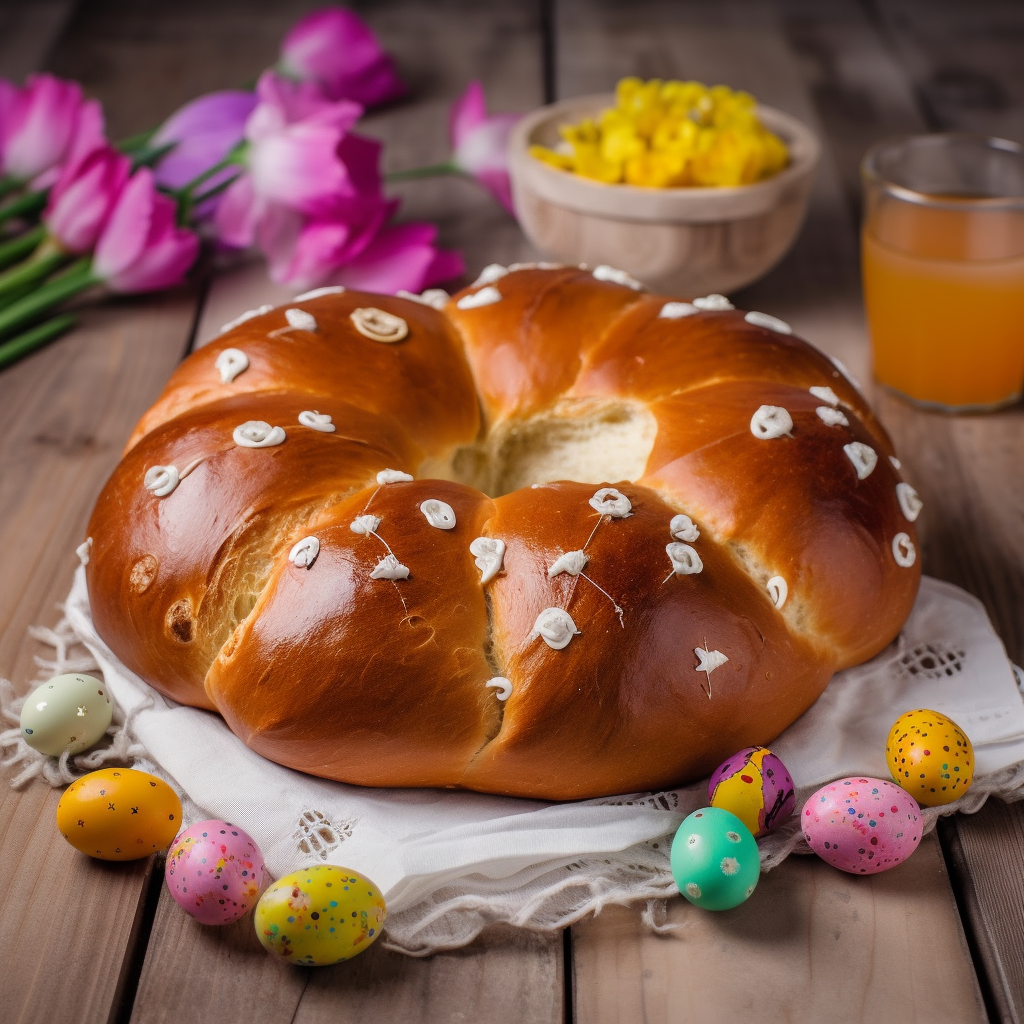Hey,Welcome to my kittchen Beyond the Bayou Blog, where I share my love for baking and cooking. Today I’m gonna share with you Italian Easter Bread Recipe. I’m just your average home cook trying to make delicious meals like Oat Bread, Banana Bread and many more for my loved ones. One thing I’ve learned on this journey is that some recipes are more than just food—they’re memories waiting to be made.
I remember the first time I attempted to make Italian Easter bread. It was a sunny Saturday morning, and I had decided to tackle this traditional recipe I found online. As I gathered the ingredients and started kneading the dough, I couldn’t help but feel a sense of excitement mixed with a hint of nervousness. Would it turn out as delicious as I hoped? Would my family enjoy it?
As the sweet aroma of the bread filled my kitchen and the colorful Easter eggs nestled into the dough, I felt pride. This wasn’t just about making bread; it was about creating something special for my family to enjoy together. When I finally pulled the golden loaves out of the oven and saw the smiles on their faces, I knew it was worth the effort.
Since then, Italian Easter bread has become a cherished tradition in our home. Every year, as Easter approaches, we gather in the kitchen to mix, knead, and bake this sweet treat together. It’s not just about the bread; it’s about the memories we create along the way. So roll up our sleeves, preheat the oven, and get cooking.
What is Italian Easter Bread?
Italian Easter bread, also known as “Pane di Pasqua,” is a traditional sweet bread made especially for Easter celebrations in Italy. It’s a soft, slightly sweet bread that’s often flavored with ingredients like citrus zest, anise, or vanilla. The dough is sometimes braided or shaped into decorative forms, like wreaths or crosses, symbolizing the holiday’s significance.It’s a delightful way to celebrate the holiday with family and friends, sharing not only delicious flavors but also the joy and spirit of Easter.
Overview: How to make Italian Easter Bread Recipe?

To make Italian Easter bread, start by warming milk until it’s lukewarm. Add yeast and a bit of sugar to activate it. Let it sit for a few minutes until it gets foamy. In a large bowl, mix flour, sugar, salt, and any flavorings you like, such as citrus zest or anise seeds. Then, add the yeast mixture, along with softened butter and eggs. Knead the dough until it’s smooth and elastic.
Let the dough rise in a warm place until it doubles in size, usually about an hour. Once risen, divide the dough into portions and shape them into braids, wreaths, or any other desired shape. Tuck dyed Easter eggs into the dough for decoration. Let the shaped loaves rise again until they puff up.
Brush the risen loaves with an egg wash to give them a shiny finish. Bake in a preheated oven until golden brown and cooked through. Once baked, let the bread cool before slicing and serving. Enjoy your homemade Italian Easter bread with loved ones during the holiday festivities.
Italian Easter Bread Recipe
Equipment
- Mixing Bowl
- Measuring cups and spoons
- Mixer (optional)
- Baking sheet
- Parchment Paper or Silicone Baking Mat
- Pastry Brush
- Oven
- Cooling Rack
- Easter Eggs (optional)
Ingredients
- 1 1/4 cups milk or half and half
- 1/3 cup unsalted butter
- 2 1/4 teaspoons instant yeast
- Pinch of salt about 1/16 teaspoon
- 2 eggs lightly beaten
- 1/2 cup sugar
- 4 cups bread flour approximate
- 1 large egg
- 1 teaspoon water
- Rainbow nonpareils
- 6 raw eggs room temperature dyed in rainbow colors
Instructions
- Activate Yeast: Warm milk and mix with yeast and a bit of sugar. Let it sit until foamy.
- Prepare Dough: Combine flour, sugar, salt, and flavorings in a mixing bowl. Add yeast mixture, softened butter, and eggs. Knead until smooth.
- First Rise: Place dough in a greased bowl, cover, and let it rise until doubled in size, about 1 hour.
- Shape Loaves: Divide dough and shape into desired forms, like braids or wreaths. Nestle dyed Easter eggs into the dough.
- Second Rise: Let shaped loaves rise again until they puff up, about 30 minutes.
- Preheat Oven: Meanwhile, preheat the oven to the specified temperature.
- Egg Wash: Brush risen loaves with egg wash for a shiny finish.
- Bake: Place loaves on a baking sheet lined with parchment paper or a silicone mat. Bake until golden brown and cooked through.
- Cool: Transfer baked bread to a cooling rack and let it cool completely before slicing and serving.
Notes
Nutrition
Time for the Tips!
- Use Fresh Ingredients: Fresh ingredients like active yeast and eggs will yield the best results.
- Properly Activate Yeast: Ensure your yeast mixture becomes foamy before adding it to the dough. If it doesn’t foam, the yeast may be inactive, and your bread won’t rise properly.
- Knead the Dough Well: Kneading the dough thoroughly helps develop gluten, giving the bread its desired texture. It should be smooth and elastic.
- Allow Sufficient Rising Time: Let the dough rise in a warm, draft-free place until it doubles in size. This step is crucial for achieving a light and fluffy texture.
- Get Creative with Shapes: Have fun shaping your Italian Easter bread into braids, wreaths, or other decorative forms. Don’t forget to nestle dyed Easter eggs into the dough for a festive touch.
- Apply Egg Wash Generously: Brushing the risen loaves with egg wash before baking gives them a beautiful golden color and shine.
- Monitor Baking Closely: Keep an eye on the bread while it’s baking to prevent over-browning. If necessary, cover it loosely with foil halfway through baking.
- Allow Bread to Cool: Let the baked bread cool completely on a wire rack before slicing. This allows the flavors to develop and prevents it from becoming soggy.
What to serve with Italian Easter Bread?

To preserve bread from Becoming Soggy!
- Cool Completely: Allow the bread to cool completely on a wire rack before storing it. This helps prevent condensation from forming inside the storage container, which can lead to sogginess.
- Store Properly: Store the bread in an airtight container or resealable plastic bag to protect it from moisture in the air. Make sure the container is completely dry before adding the bread.
- Use Paper Towels: If you notice any excess moisture on the surface of the bread, gently blot it with paper towels before storing. This helps absorb any moisture that could lead to sogginess.
- Avoid Refrigeration: Avoid storing bread in the refrigerator, as the cold temperature can accelerate moisture absorption and lead to soggy bread.
- Reheat Properly: If the bread becomes slightly stale or loses its freshness, you can revive it by reheating it in the oven. Place the bread in a preheated oven at 300°F (150°C) for 5-10 minutes, or until warmed through. This helps remove excess moisture and restores some of the bread’s texture.
What to do with Leftover?
- French Toast: Transform slices of leftover bread into a decadent breakfast by making French toast. Dip the slices in a mixture of beaten eggs, milk, and cinnamon, then fry them until golden brown. Serve with maple syrup or your favorite toppings.
- Panini or Grilled Sandwiches: Slice the bread and use it to make delicious panini or grilled sandwiches. Fill them with your favorite ingredients such as cheese, deli meats, vegetables, and spreads for a satisfying lunch or dinner.
- Bread Salad: Cube the leftover bread and toss it with tomatoes, cucumbers, bell peppers, red onions, and fresh herbs to make a flavorful bread salad. Dress with olive oil, balsamic vinegar, salt, and pepper for a refreshing side dish.
- Bread Croutons: Cut the bread into cubes, toss them with olive oil, garlic powder, and herbs, and then bake them in the oven until crispy to make homemade croutons. Use these croutons to top salads or soups for added crunch.
- Bread Pizzas: Slice the bread horizontally, top with pizza sauce, cheese, and your favorite toppings, and then bake until the cheese is melted and bubbly for a quick and easy pizza night.
- Bread Stuffing: Cube the bread and use it to make a flavorful stuffing for poultry, pork, or vegetables for a delicious side dish.
Frequently Asked Questions(FAQs)
Q: What makes Italian Easter bread different from regular bread?
A: Italian Easter bread is typically sweeter and enriched with ingredients like sugar, eggs, and butter compared to regular bread. It often contains flavorful additions like citrus zest or anise seeds and is decorated with Easter eggs.
Q: What is the significance of the Easter eggs in Italian Easter bread?
A: The Easter eggs nestled into the dough of Italian Easter bread symbolize new life and rebirth, which are central themes of the Easter holiday. They represent the resurrection of Jesus Christ and the hope of eternal life.
Q: Can I customize Italian Easter bread with different flavors?
A: Yes, you can customize Italian Easter bread with various flavors according to your preferences. Popular additions include lemon or orange zest, almond extract, rum-soaked raisins, or spices like cinnamon or nutmeg.

